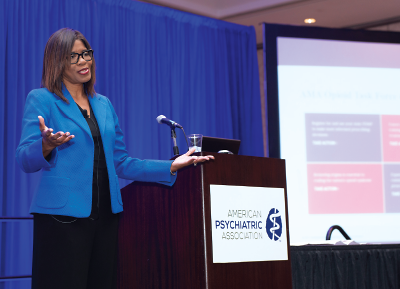Some Progress Being Made In Stemming Opioid Crisis
Abstract
Psychiatrist Patrice Harris, M.D., says that while there are signs of progress in physicians’ prescribing practices and training in pain and addiction treatment, much more is needed to end the opioid epidemic.
As a trained psychiatrist, Patrice Harris, M.D., understands her professional responsibility to help combat the growing opioid epidemic. But Harris, who chairs the AMA Task Force on Opioids, also feels a personal connection to the communities hit hardest by the crisis, she told an audience gathered at IPS: The Mental Health Services Conference in October.

Patrice Harris, M.D., says she has been encouraged by the increased use of prescription drug monitoring programs, but she hopes that these electronic databases can be transformed from reference tools into clinical tools.
“WVU [West Virginia University] is my alma mater,” she said. “And the state has become a sort of ground zero for this current epidemic.”
As Harris explained during her IPS talk, the AMA in 2014 convened representatives from 25 national, state, and specialty medical organizations to form the AMA Opioid Task Force. The task force established six goals for physicians to help fight the opioid epidemic:
Register and use state prescription drug monitoring programs (PDMPs).
Enhance education and training.
Support comprehensive treatment for pain and substance use disorders.
Help end stigma.
Co-prescribe naloxone to patients at risk of overdose.
Encourage safe storage and disposal of opioids and all medications.
Harris told the audience that there are some signs that physicians are working to meet these goals. For instance, physicians’ and other health care professionals’ registrations with state-based PDMPs—electronic databases that monitor controlled substance prescriptions—grew from 471,896 in 2014 to 1,322,996 in 2016. These professionals aren’t just registering with the state; data show use of the state PDMPs is also on the rise. In 2016, health care professionals checked the state PDMPs more than 136.1 million times—a 121 percent increase from 2014.
A growing number of physicians are also completing courses on opioid prescribing, pain management, and addiction. According to an AMA survey, more than 118,550 physicians accessed, attended, or completed continuing medical education and other courses offered by the AMA, state, and specialty societies.
Two important prescribing statistics have also been trending in the right directions. The total number of opioid prescriptions written fell from 244 million in 2014 to 215 million in 2016; meanwhile, according to the AMA, 32,659 prescriptions of the overdose blocker naloxone were dispensed in the first two months of 2017, a record 340 percent increase from 2016. A growing number of physicians have also received certification to provide office-based medication-assisted treatment for patients with opioid use disorder.
Harris, who is in private practice and serves as an adjunct professor of psychiatry at Emory University, said that while these are signs of progress, there is much more work to be done to truly reverse the nation’s opioid epidemic. As physicians and organizations such as the AMA and APA consider next steps, Harris said it is important to remain “intellectually honest” about the role physicians and patients play in the continued misuse of opioids.
She noted that while reports suggest that some physicians knowingly overprescribed opioids, there are also well-intentioned doctors who may err on the side of medication when not necessary—and these two groups require different solutions. In addition, many of these prescription opioids likely got in the wrong hands because patients did not properly secure them.
Harris added that more data are needed to properly inform public policy and greater attention needs to be paid to the data already available. As an example, she cited the statistic that only 2 in 10 people with a substance use disorder get the care they need.
“I’m sure many of us can share a story about referral problems,” Harris said. “You call a treatment center, but you know what the answer on the other end is: ‘We have no space.’ No one with diabetes comes to a hospital with a blood glucose level of over 600 and gets told, ‘We don’t have a bed. Come back in four weeks.’ ” ■
More information on the AMA Opioid Task Force can be accessed here.



